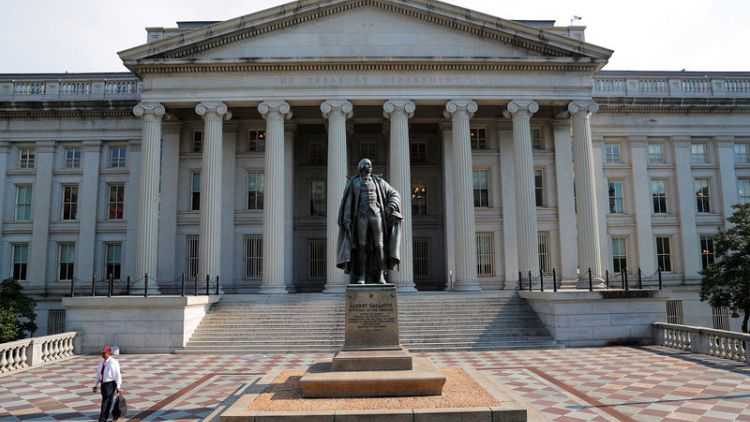By Gertrude Chavez-Dreyfuss
NEW YORK (Reuters) - While there seems to be no end on the horizon to this year's dramatic rally in U.S. Treasuries that has collapsed yields more than a full percentage point, conditions are ripening for a reversal that could disrupt the market.
Some signals analysts track point to higher yields, although no one knows when the shift is coming.
The consensus view is that U.S. yields could go even lower. A protracted U.S.-China trade war, a darkening global economic outlook, and the Federal Reserve's monetary easing stance are bullish for Treasury prices.
Still, yields this low are getting harder to justify, some analysts said. Some investors have hedged against a possible U.S. rate rise by reducing holdings of long-term bonds and grabbing other fixed-income products such as private debt and structured credit.
"This feels to me like dot-com level cockiness on this side of the bond bulls," said Kevin Muir, market strategist at East West Investment Management in Toronto.
"I would just caution as somebody who has been through a lot of market shifts, that as we get more and more euphoric and more volatile, the chances of a big move, snapping back and hurting people in a big way will increase dramatically," he added.
U.S. 10-year and 30-year yields have both dropped more than 100 basis points since January, on track for their steepest fall in eight and five years. Ten-year yields are currently at 1.521%, while 30-year yields are at 1.988% after hitting a record low on Wednesday of 1.905%.
Graphic - Biggest monthly fall in 30-year USTs since 2011: https://fingfx.thomsonreuters.com/gfx/editorcharts/MARKETS-MILESTONES-FACTBOX/0H001QESK83N/eikon.png
Evercore ISI technical analyst Rich Ross said the 10-year yield is the most oversold since 1998.
The one-month Merrill Lynch MOVE index, which tracks the one-month implied volatility for the 10-year Treasury yield, hit a more than three-year peak of 91.822 last week, suggesting expectations of major price moves.
Investors had wondered about the prospect of U.S. bond yields below zero as negative yields have become a mainstay in Europe and Japan. The United States is expected to avoid this fate, but some have not ruled it out.
Longer dated U.S. Treasuries have led the rally, prompting a yield curve inversion, where shorter-dated borrowing costs are higher than longer ones. An inversion is widely viewed as a signal of a looming recession.
The premium on 2-year yields above 10-year yields narrowed a bit on Thursday to -1.40 basis points.
"It's very difficult to look at the curve right now and see much attraction in Treasuries here," said Bill Merz, director of fixed income at U.S. Bank Wealth Management in Minneapolis, who helps oversee $170 billion (138.5 billion pounds) in assets.
U.S. Bank is maintaining its neutral core bond allocations and is slightly underweight duration, Merz said.
Duration, expressed in years, measures how much a bond's price will move when the Federal Reserve changes interest rates. The longer the duration, the higher the bond's sensitivity to interest rate changes.
Merz qualified though that the slight underweight duration was "primarily to make room for a structured credit allocation that we see as more attractive than traditional core bonds, so non-agency mortgages, and other structured credit products."
TREASURY RALLY TURNING?
Stan Shipley, fixed income strategist at Evercore ISI in New York said it was tough to call a major turning point in 10-year Treasury yields, but several indicators suggest the rally in bonds is nearing an end.
Evercore ISI's economic diffusion index (EDI) which tends to lead the 10-year yield by around six months has turned higher, Shipley said, adding that other tactical indicators also point to higher rates.
A J.P. Morgan survey showed last week that bond investors have already scaled back bullish bets on U.S. longer-dated government debt.
Graphic - Investors positions in longer-dated US Treasuries : https://fingfx.thomsonreuters.com/gfx/editorcharts/TREASURIES-JPMORGAN/0H001PBDZ4X5/eikon.png
Aside from technical factors, a fiscal response to economic recession fears, such as more spending and tax cuts from the U.S. government, would likely push Treasury yields higher as well.
Financing additional government spending would require selling more Treasuries, which should lift yields. More importantly, analysts said increased fiscal spending signals a commitment to boosting economic growth.
Jonas Goltermann, senior markets economist, at Capital Economics in London, said the sharp rise in bond yields in November 2016 after U.S. President Donald Trump was elected and in early 2018 after Congress passed his tax cuts shows the impact of fiscal policy on bond markets can be substantial.
East West's Muir said he was surprised governments around the world are not spending enough to take advantage of record low yields.
"But I am confident that governments are going to figure out how to spend and it would be the biggest surprise that the bond market has ever seen."
(Reporting by Gertrude Chavez-Dreyfuss; Editing by Alden Bentley and David Gregorio)



